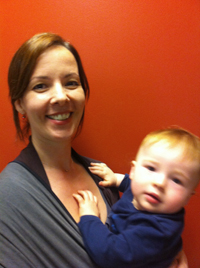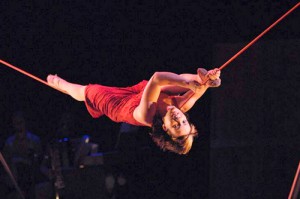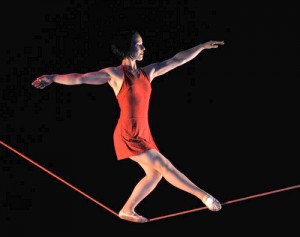Warriors in the World: Beth Clarke
 While we all strive for balance in our lives, Beth Clarke is accomplished at one distinctive discipline that requires her equilibrium to be in constant flux: the slack rope. A founding member of the San Francisco circus troupe Sweet Can Productions, Beth’s vision and range of theatrical and circus skills contribute fundamentally to their warm and creative performances.
While we all strive for balance in our lives, Beth Clarke is accomplished at one distinctive discipline that requires her equilibrium to be in constant flux: the slack rope. A founding member of the San Francisco circus troupe Sweet Can Productions, Beth’s vision and range of theatrical and circus skills contribute fundamentally to their warm and creative performances.
Her specialty is the slack rope, which she has practiced since she was in her teens at the National Circus School in Montreal. She recalls standing on the rope in the big beautiful hall called Chapiteau (the big top): “I just knew in one instant it was the thing for me. I felt the special quality of the space I got to inhabit up there on the rope. I loved the feeling of pure and utter presence that it required I have — complete mind and body connection, but not conceptual, not abstract, just very real. I was either on top of that rope or I wasn’t, and I was either in an ease-ful state of balance or I wasn’t. Balancing on the rope gives me permission to fully occupy the space my body takes up.”
 Beth spent years traveling and studying with various ensembles bearing names like Make*A*Circus, Cirque Eloize, and The Pickle Family Circus. Visit her website here to sense the full dimension of her career. Beth has had more teachers in her circus life than she can easily recount. She considers Szilard Szeleky her “true” slack rope teacher, and trained with him for hours over a three-year period. “His whole approach was to teach me to fall off the rope in every imaginable way, so classes with him were about directly facing my fear of groundlessness! Literally. I remember one class, it was late after a long day of rehearsing and I was swinging on the rope and I just wouldn’t let myself fall. He said Cade, cade cara, e possiamo andare a casa. (‘Fall, fall my dear, and then we can all go home.’)”
Beth spent years traveling and studying with various ensembles bearing names like Make*A*Circus, Cirque Eloize, and The Pickle Family Circus. Visit her website here to sense the full dimension of her career. Beth has had more teachers in her circus life than she can easily recount. She considers Szilard Szeleky her “true” slack rope teacher, and trained with him for hours over a three-year period. “His whole approach was to teach me to fall off the rope in every imaginable way, so classes with him were about directly facing my fear of groundlessness! Literally. I remember one class, it was late after a long day of rehearsing and I was swinging on the rope and I just wouldn’t let myself fall. He said Cade, cade cara, e possiamo andare a casa. (‘Fall, fall my dear, and then we can all go home.’)”
Reflecting that she learned a lot from Szilard about self-aggression, Beth recognizes that “for years I trained because I didn’t think I was good enough as I was. (I think almost all artists do this.) There was truth in it — I did need to improve my technique, but watching Szilard rail against himself, I swore to myself I did not want to perpetuate that, and started to try to shift my motivation for practice from that aggressive way of wishing I were different than I am, to learning who I am, and finding the way that I could share that in my own unique way as a circus artist.” Beth began to move away from aggressively training to “trying to unmask my true voice as an artist and to have the courage to express it — hopefully allowing me to be more authentic both in life and in performance.”
Having read Pema Chodron, Beth’s intersection with Shambhala began in January 2010, when she participated in a Shambhala Training weekend — the first program held after the San Francisco Center’s relocation to Stevenson Street. Citing what attracted her to meditation and mindfulness, and its parallels to performance disciplines, Beth says “Walking the rope, and all of my circus pursuits, were my first mindfulness practice. To steady the rope, I had to steady my breath, and as my breath steadied, my mind would follow.”
A variety of circus situations led her throughout North America and Europe. “In performance I had to have all my antennae open to what was truly happening, both on stage with colleagues and especially in the audience. When there was a mistake it was always so much better to acknowledge it. The audience appreciated that, and I could feel that then they were on my side, rooting for me (or any of us) to succeed. There is nothing better than that collective exhale from the audience when a performer does a trick they have missed, especially if the performer can be a bit vulnerable with the audience, acknowledging that they missed the trick and asking for support to try it again.
“I think this gave me some confidence to try it out in real life. To be vulnerable, to acknowledge what is truly happening, or simply to have a smidgen of courage that I could, indeed, trust the present moment. I feel like every teaching I have received in Shambhala I can relate to a specific moment I have experienced while performing or training for circus.”
Beth and her husband, also a circus performer, have a three-year-old son, Oliver, whom she describes as “very physical” and who thinks that standing on his head is completely normal. “Motherhood has changed me profoundly,” she says. “Parenting is another place where I can apply every teaching I have received in Shambhala. Having a child has made me care about the world in a far more personal way. It has made me more dedicated to creating quality live entertainment for families, and to children seeing real people (not animation), in real time, in front of them, doing amazing things with their bodies.
“Not to sound too dramatic, but I am really concerned about the physical well-being of children right now. I think they don’t move enough; they are not in their bodies. They are defenseless to the power of the screen! Think how hard it can be for us adults to tear ourselves away from our screens; for a child it is ten times more difficult.”
 Sweet Can Productions (“When Sour Can’t, Sweet Can!” is their catchphrase) was founded in 2006 to create intimate, heartfelt performances in which audience and performer connect with one another. Having produced three successful shows and a recurring winter cabaret, Sweet Can recently presented a special show called My Friend Hafiz in San Francisco in collaboration with the acoustic musical group The Levins. My Friend Hafiz presents songs drawn from the ecstatic poetry of the Persian poet Hafiz, written and recorded by The Levins. The performance included aerial tissu, hoop, straps, hula hoops, acrobatics, dance, clowning, story telling in English and Farsi, a six-piece live band and, of course, slack rope. Find more information about Sweet Can on their site here, and about The Levins on their site here.
Sweet Can Productions (“When Sour Can’t, Sweet Can!” is their catchphrase) was founded in 2006 to create intimate, heartfelt performances in which audience and performer connect with one another. Having produced three successful shows and a recurring winter cabaret, Sweet Can recently presented a special show called My Friend Hafiz in San Francisco in collaboration with the acoustic musical group The Levins. My Friend Hafiz presents songs drawn from the ecstatic poetry of the Persian poet Hafiz, written and recorded by The Levins. The performance included aerial tissu, hoop, straps, hula hoops, acrobatics, dance, clowning, story telling in English and Farsi, a six-piece live band and, of course, slack rope. Find more information about Sweet Can on their site here, and about The Levins on their site here.
“We (Sweet Can members) were all struck by the beauty and truth in the Hafiz poetry,” Beth explains. “We immediately saw a link between the way circus and poetry can, in one instant, directly help us to touch into our humanity, and in doing so open us up to the world and to others. I am constantly astounded that we are working with material written on the other side of the world, 700 years ago, where external conditions were quite different; but since it is such an honest and loving description of the human experience, it applies to our current 21st century American way of life.
“This makes me think of when Pema Chodron once said, after reading text from Shantideva, ‘So you see, on the level of human neurosis, not much has changed in the past 500 years.’
“What traps us as humans is still the same, and what liberates us is still the same — touching into our humanity, allowing beauty to touch us and to move us into the present moment, and to remind us to appreciate the extraordinary good fortune of having this precious human life, even with all our foibles, pain and confusion. It is our aspiration to create performances in which people are moved by the beauty and tenderness of being human. Wish us luck!!!”
Here’s a summary thought from Hafiz, in the shape of a poem translator Daniel Ladinsky calls “Dropping Keys:”
The small man builds cages for everyone he knows,
While the sage, who has to duck his head when the moon is low,
Keeps dropping keys all night long for the beautiful rowdy prisoners.
– Article shaped by Steve Schurkey, September 2014
